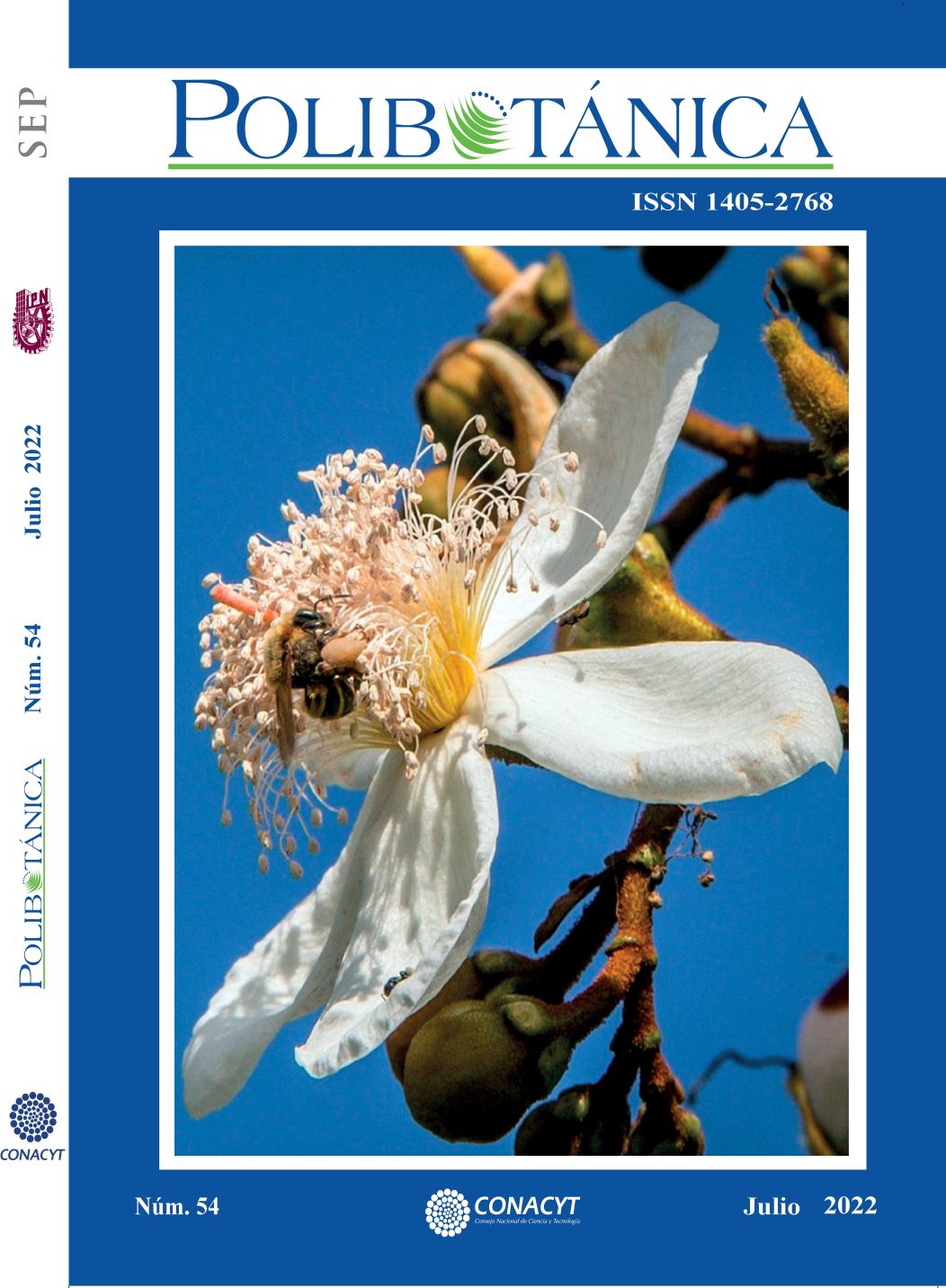Comparison of mangrove structural values in different conditions of ecological degradation
DOI:
https://doi.org/10.18387/polibotanica.54.4Keywords:
degradation, mangrove, disturbance, hydrodynamicsAbstract
Changes in hydrology in mangroves translate into well-defined degradation gradients that mainly translate into a decrease in their structure. A good estimator of the structure of a forest is the Complexity Index, which relates density, basal area, height and the number of species present in 0.1 ha. A neotropical mangrove swamp located within Ramsar site No. 1602 was fragmented by the construction of three solid structures across the width of the forest. This eventually caused the degradation of the forest, with three scenarios, apparently undegraded sections, semi-degraded and complete mortality. The present work, based on the Complexity Index, seeks to find changes in the behavior of the tree structure and regeneration that show the degradation process. A reference site was established and four more transects were made covering the width of the mangrove and all degradation scenarios. Quadrants were made every 25 m, taking the indicators to process the Complexity Index. The reference site presented the best regeneration value and the second best in tree structure in relation to the forest fragments. When comparing for the degradation condition, the reference site and the area that apparently is not degraded had close values, not the semi-degraded condition that presented values much lower, mainly attributed to its low density and height of its individuals. Compared to the reference site, the apparently non-degraded areas of the forest fragments have good structural development and regeneration, so a rehabilitation is feasible to solve the stress caused and begin its recovery, not so for the total mortality area. , which requires active intervention to begin a slow process that leads to its integration into the other areas.
References
Bakhtiyari, M., Lee, S. Y., y Warnken, J. (2019). Seeing the forest as well as the trees: An expert opinion approach to identifying holistic condition indicators for mangrove ecosystems. Estuarine, Coastal and Shelf Science, 222, 183–194. https://doi.org/10.1016/J.ECSS.2019.03.003
Blanco, J. F., Bejarano, A. C., Lasso, J., y Cantera, J. R. (2001). A new look at computation of the complexity index in mangroves: do disturbed forests have clues to analyze canopy height patchiness? Wetlands Ecology and Management, 9(2). https://doi.org/10.1023/A:1011115220126
Bosire, J. O., Kaino, J. J., Olagoke, A. O., Mwihaki, L. M., Ogendi, G. M., Kairo, J. G., Berger, U., y Macharia, D. (2014). Mangroves in peril: unprecedented degradation rates of peri-urban mangroves in Kenya. Biogeosciences, 11(10). https://doi.org/10.5194/bg-11-2623-2014
Cintron, G., Lugo, A. E., Pool, D. J., y Morris, G. (1978). Mangroves of Arid Environments in Puerto Rico and Adjacent Islands. Biotropica, 10(2). https://doi.org/10.2307/2388013
Cintrón, G., y Schaeffer-Novelli, Y. (1983). Introducción a la ecología del manglar. ROSTLAC-UNESCO.
Corella, F., Valdez, J., Cetina, V., González, F., Trinidad, A., y Aguirre, J. (2001). Estructura forestal de un bosque de mangles en el noreste del estado de Tabasco, México. Ciencia Forestal En México, 26(90), 73–102.
da Souza, I., Bonomo, M. M., Morozesk, M., Rocha, L. D., Duarte, I. D., Furlan, L. M., Arrivabene, H. P., Monferrán, M. V., Matsumoto, S. T., Milanez, C. R. D., Wunderlin, D. A., y Fernandes, M. N. (2014). Adaptive plasticity of Laguncularia racemosa in response to different environmental conditions: integrating chemical and biological data by chemometrics. Ecotoxicology, 23(3). https://doi.org/10.1007/s10646-014-1191-0
Duke, N. C. (2001). Gap creation and regenerative processes driving diversity and structure of mangrove ecosystems. Wetlands Ecology and Management, 9(3). https://doi.org/10.1023/A:1011121109886
El-Juhany, L. (2009). Present status and degradation trends of mangrove forests on the southern Red Sea coast of Saudi Arabia. American-Eurasian Journal of Agricultural & Environmental Sciences, 6, 328–340.
Estrada, G. C. D., Soares, M. L. G., Chaves, F. de O., y Cavalcanti, V. F. (2013). Analysis of the structural variability of mangrove forests through the physiographic types approach. Aquatic Botany, 111. https://doi.org/10.1016/j.aquabot.2013.06.003
FAO. (1994). Mangrove forest management guidelines (Forestry Departament (Ed.)). FAO.
Feller, I. C., Lovelock, C. E., Berger, U., McKee, K. L., Joye, S. B., y Ball, M. C. (2010). Biocomplexity in Mangrove Ecosystems. Annual Review of Marine Science, 2(1). https://doi.org/10.1146/annurev.marine.010908.163809
George, G., Krishnan, P., Mini, K. G., Salim, S. S., Ragavan, P., Tenjing, S. Y., Muruganandam, R., Dubey, S. K., Gopalakrishnan, A., Purvaja, R., y Ramesh, R. (2019). Structure and regeneration status of mangrove patches along the estuarine and coastal stretches of Kerala, India. Journal of Forestry Research, 30(2). https://doi.org/10.1007/s11676-018-0600-2
Grime, J. P. (1977). Evidence for the Existence of Three Primary Strategies in Plants and Its Relevance to Ecological and Evolutionary Theory. The American Naturalist, 111(982). https://doi.org/10.1086/283244
Herrera-Silveira, J. A., Pech-Cardenas, M. A., Morales-Ojeda, S. M., Cinco-Castro, S., Camacho-Rico, A., Caamal Sosa, J. P., Mendoza-Martinez, J. E., Pech-Poot, E. Y., Montero, J., y Teutli-Hernandez, C. (2020). Blue carbon of Mexico, carbon stocks and fluxes: a systematic review. PeerJ, 8. https://doi.org/10.7717/peerj.8790
Holdridge, L. (1967). Life zone ecology. Tropical Science Center.
Jiménez, M. del C., y González, F. (1996). Análisis de la estructura del manglar de la laguna de Juluápan, Col., México. Ciencia Pesquera, 12, 76–84.
Kearney, M. S., Rogers, A. S., Townshend, J. R. G., Rizzo, E., Stutzer, D., Stevenson, J. C., y Sundborg, K. (2002). Landsat imagery shows decline of coastal marshes in Chesapeake and Delaware Bays. Eos, Transactions American Geophysical Union, 83(16). https://doi.org/10.1029/2002EO000112
Keim, R. F., Zoller, J. A., Braud, D. H., y Edwards, B. L. (2013). Classification of Forested Wetland Degradation Using Ordination of Multitemporal Reflectance. Wetlands, 33(6). https://doi.org/10.1007/s13157-013-0466-1
Kovacs, J. M., King, J. M. L., Flores de Santiago, F., y Flores-Verdugo, F. (2009). Evaluating the condition of a mangrove forest of the Mexican Pacific based on an estimated leaf area index mapping approach. Environmental Monitoring and Assessment, 157(1–4). https://doi.org/10.1007/s10661-008-0523-z
Lara-Domínguez, A. L., Day, J. W., Zapata, G. V., Twilley, R. R., Guillén, H. A., y Yáñez-Arancibia, A. (2005). Structure of a unique inland mangrove forest assemblage in fossil lagoons on the Caribbean Coast of Mexico. Wetlands Ecology and Management, 13(2). https://doi.org/10.1007/s11273-004-5197-x
Lewis, R. R., Milbrandt, E. C., Brown, B., Krauss, K. W., Rovai, A. S., Beever, J. W., y Flynn, L. L. (2016). Stress in mangrove forests: Early detection and preemptive rehabilitation are essential for future successful worldwide mangrove forest management. Marine Pollution Bulletin, 109(2). https://doi.org/10.1016/j.marpolbul.2016.03.006
López-Portillo, J., Lara, A., Martínez, M., Hernández, M., Rodríguez, M., Ureña, C., Galán, R., Vásquez, V., y Sáinz, E. (2012). Programa regional para la caracterización y el monitoreo de ecosistemas de manglar del Golfo de México y Caribe Mexicano: inicio de una red multi-institucional.
Loría-Naranjo, M., Samper-Villarreal, J., y Cortés, J. (2015). Structural complexity and species composition of Potrero Grande and Santa Elena mangrove forests in Santa Rosa National Park, North Pacific of Costa Rica. Revista de Biología Tropical, 62(4). https://doi.org/10.15517/rbt.v62i4.20030
Lugo, A., y Cintrón, G. (1975). The mangrove forests of Puerto Rico and their management. In G. Walsh, S. Snedaker, & H. Teas (Eds.), Proceedings of the International Symposium on Biology and Management of Mangroves (Vol. 2, pp. 825–846). Institute of Food and Agricultual Sciences.
Lugo, A. E., Medina, E., y McGinley, K. (2014). Issues and Challenges of Mangrove conservation in the Anthropocene. Madera y Bosques, 20. https://doi.org/10.21829/myb.2014.200146
McWilliams, W., Westfall, J., Brose, P., Dey, D., Hatfield, M., Johnson, K., Laustsen, K., Lehman, S., Morin, R., Nelson, M., Ristau, T., Royo, A., Stout, S., Willard, T., y Woodall, C. (2015). A regeneration Indicator for Forest Inventory and Analysis: History, sampling, estimation, analytics, and potential use in the Midwest and Northeast United States.
Noguera, A. (2016). Metodologías para evaluar vulnerabilidad del bosque frente al cambio climático. In Adaptación al cambio climático incorporando metodologías de información con enfoque de género y seguridad alimentaria. . Fundación Ayuda en Acción. Instituto Hondureño de Ciencias de la Tierra y Fundación para la Investigación del Clima.
Pool, D. J., Snedaker, S. C., y Lugo, A. E. (1977). Structure of Mangrove Forests in Florida, Puerto Rico, Mexico, and Costa Rica. Biotropica, 9(3). https://doi.org/10.2307/2387881
Proisy, C., Viennois, G., Sidik, F., Andayani, A., Enright, J. A., Guitet, S., Gusmawati, N., Lemonnier, H., Muthusankar, G., Olagoke, A., Prosperi, J., Rahmania, R., Ricout, A., Soulard, B., y Suhardjono. (2018). Monitoring mangrove forests after aquaculture abandonment using time series of very high spatial resolution satellite images: A case study from the Perancak estuary, Bali, Indonesia. Marine Pollution Bulletin, 131. https://doi.org/10.1016/j.marpolbul.2017.05.056
Razali, S. M., Nuruddin, A. A., y Lion, M. (2019). Mangrove Vegetation Health Assessment Based on Remote Sensing Indices for Tanjung Piai, Malay Peninsular. Journal of Landscape Ecology, 12(2). https://doi.org/10.2478/jlecol-2019-0008
Satyanarayana, B., Mohamad, K. A., Idris, I. F., Husain, M.L., y Dahdouh-Guebas, F. (2011). Assessment of mangrove vegetation based on remote sensing and ground-truth measurements at Tumpat, Kelantan Delta, East Coast of Peninsular Malaysia. International Journal of Remote Sensing, 32(6). https://doi.org/10.1080/01431160903586781
Shaffer, G. P., Wood, W. B., Hoeppner, S. S., Perkins, T. E., Zoller, J., y Kandalepas, D. (2009). Degradation of Baldcypress–Water Tupelo Swamp to Marsh and Open Water in Southeastern Louisiana, U.S.A.: An Irreversible Trajectory? Journal of Coastal Research, 10054. https://doi.org/10.2112/SI54-006.1
Shirer, R., y Zimmerman, C. (2010). Forest regeneration in New York State.
Soto, R., y Jiménez, J. (1982). Análisis fisionómico estructural del manglar de Puerto Soley, La Cruz, Guanacaste, Costa Rica. Revista Biología Tropical, 30, 161–168.
Tsitsoni, T. (1997). Conditions determining natural regeneration after wildfires in the Pinus halepensis (Miller, 1768) forests of Kassandra Peninsula (North Greece). Forest Ecology and Management, 92(1–3). https://doi.org/10.1016/S0378-1127(96)03909-6
Velázquez-Pérez, C., Tovilla-Hernández, C., Romero-Berny, E. I., y De Jesús-Navarrete, A. (2019). Estructura del manglar y su influencia en el almacén de carbono en la Reserva La Encrucijada, Chiapas, México. Madera y Bosques, 25(3). https://doi.org/10.21829/myb.2019.2531885
Volpato, M. M. (1994). Regeneração natural em uma floresta secundária no domínio de Mata Atlântica: uma análise fitossociológica. Universidade Federal de Viçosa.
Vovides, A. G., López-Portillo, J., y Bashan, Y. (2011). N2-fixation along a gradient of long-term disturbance in tropical mangroves bordering the gulf of Mexico. Biology and Fertility of Soils, 47(5). https://doi.org/10.1007/s00374-011-0562-4
Wang, W., Fu, H., Lee, S. Y., Fan, H., y Wang, M. (2020). Can Strict Protection Stop the Decline of Mangrove Ecosystems in China? From Rapid Destruction to Rampant Degradation. Forests, 11(1). https://doi.org/10.3390/f11010055
Zamprogno, G. C., Tognella, M. M. P., Quaresma, V. da S., Costa, M. B. da Pascoalini, S. S., y Couto, G. F. (2016). The structural heterogeneity of an urbanised mangrove forest area in southeastern Brazil: Influence of environmental factors and anthropogenic stressors. Brazilian Journal of Oceanography, 64(2). https://doi.org/10.1590/S1679-87592016111706402
Downloads
Published
Issue
Section
License

Polibotánica by Departamento de Botánica de la Escuela Nacional de Ciencias Biológicas del Instituto Politécnico Nacional se distribuye bajo una Licencia Creative Commons Atribución-NoComercial-CompartirIgual 4.0 Internacional.




















